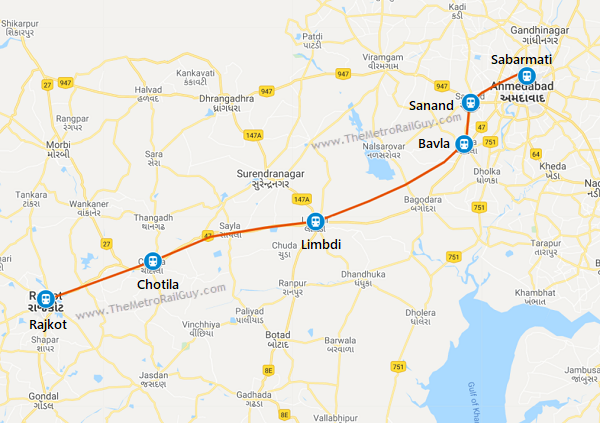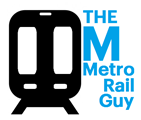3 DDC Bidders for Ahmedabad – Rajkot Semi High-Speed Rail
Three design engineering firms have submitted tenders for the first Detailed Design Consultant contract of the 227.60 km Ahmedabad – Rajkot Semi High-Speed Rail Project.
This is the first of multiple DDC contracts for this new semi high-speed rail line in Gujarat where trains will travel at a top speed of 160 kmph to link both cities through 6 stations at Sabarmati, Sanand, Bavla, Limbdi, Chotila and Rajkot. At Ahmedabad’s Sabarmati Station, riders will be able to easily interchange with the 508 km Mumbai – Ahmedabad High Speed Rail and Ahmedabad Metro, Indian Railways station, and Janmarg BRT bus station.
The scope of this contract includes DDC works for Sabarmati Station, approximately 40 kms of elevated viaduct (Sabarmati to Bavla) and a small stabling yard near Sabarmati to house a few train-sets (rolling stock) for morning services.
Gujarat Rail Infrastructure Development Corporation (G-RIDE) invited tenders for this DDC contract on February 2 with an estimate of Rs. 7.04 crore and opened technical bids on March 26 to reveal 3 firms had shown interest.
Bidders:
- B&S Engineering Consultants
- Spectrum Consultants India
- Tata Consulting Engineers (TCE)
Contract: G-RIDE/ADI-RJT/SHSR/2
Scope: Engagement of Detailed Design Consultant (DDC) for Civil, Architectural and E&M Works for the design of One elevated station (i.e., Sabarmati including Multimodal Integration Scheme), approx. 40 Km Elevated Viaduct (from Sabarmati 0 Km to Bavla 40 Km) and a stabling yard near Sabarmati for Ahmedabad-Rajkot Semi High -Speed Rail Project

The bids have now been sent for technical evaluation which can take a couple months to complete. When that is done, the financial bids of the technically qualified bidders will be opened to reveal who’s the lowest bidder and most likely DDC contractor for this package.
I’m surprised none of the regular design engineering firms like AECOM, Systra, SMEC or Egis didn’t participate, but they all probably had a good enough reason to sit out.
For more updates, check out my Home Page!
– TMRG




Could you apprise us about that probable good enough reason?
Either it doesn’t make them money or they see potential issues dealing with GRIDE down the road.
Would be nice if DDC consultants reading this can chime in. I’m curious as well.
ballastless or ballast tracks???
Should be ballastless on the viaduct. Unaware of their plans for its depot.
Tenders for Project Management Consultancy must be in line..
Makes sense
Nowadays most of these firms are interested in review/checking only not the detailed design.
Should build all new tracks elevated.
That way pilots can maintain speed without any fear.
Why can’t they just upgrade the existing Indian railways tracks to support 160kmph? What’s the need for a train that runs at mere 160kmph. High speed train I can understand but why semi-high speed?
Someone enlighten me please
Indian Railway Tracks suffer from legacy issues. A large of part of Indian Railway Network is still works on Ancient Semaphore Signalling. A Small section of current network is on Colour-light Signalling but that is not enough for High Operational speeds of 160-200 kmph. For this, ETCS level-1 signalling is implemented which can provide smaller fixed blocks along with Automatic Train Protection. The upgradation of current semaphore based network to ETCS level-1 would be very costly and would be a slow process if we want upgradation without affecting network operation for a long time.
Not to mention, current railway tracks offer lesser axle load than what high speed railway tracks require and upgrading that would also be very costly.
So the overall upgradation exercise would be much more be costlier than creating of new line altogether.
Some of those seem to be false assumptions. A very, very small part of Indian Railways’ network still uses semaphores. Large sections of high volume routes such as the Grand Trunk Route, the Grand Chord, and the Western Bay Mainline have all recently been upgraded from 110 kmph to 130 kmph capability and almost entirely feature automatic signalling. More B Grade (MPS: 130) and C Grade (MPS: 110) sections have been selected for upgradation to A Grade (MPS: 160). The New Delhi – Agra stretch, an A Grade stretch already supports such semi high speed operation.
Frontier routes are a whole other issue. Most of them feature semi-automatic signalling and in other rare cases, even semaphores and token exchanges and whatnot. You can find them in interior Karnataka, Central Maharashtra and in the northeatern states as well.
I just realised I called them “frontier” routes, but they are really just routes with low traffic volume.
Is this line will be Standard Gauge? So that, Bullet Trains can also use this line for seamless travel.
Just like Mini-Shinkansen
It is high speed, so definitely going to be standard gauge.
If it is Standard Gauge, then it will be no Problem, but 160 Kmph? It’s not enough, we need this line to run at 320 Kmph for fast commuting?
The Sword-Needle analogy comes to the mind. 160-200 maximum speed would be more than enough to cater the needs of commuters for quite a few years in the future. It’s not like that Rajkot is a big metropolis comparable to Delhi-Mumbai, or Even Ahmedabad, Vadodara.
Yup, standard gauge
First you complete from surendranagar to Rajkot double line when you think for the fast corridor
TMRG, I have a question. Is Ahmedabad-Rajkot Semi High speed line will be designed in such a way, that it can be upgrade to run at a speed of from 160 Kmph to 320 Kmph in future?
Nope, I don’t believe it is.
If you have made this track plan, there are many residential buildings certified by Auda, then what decision will be taken.
And this track plan is sure to improve
Ye semi hige speed trian work kab tak start hoga.
Kuch timeline he kay ?